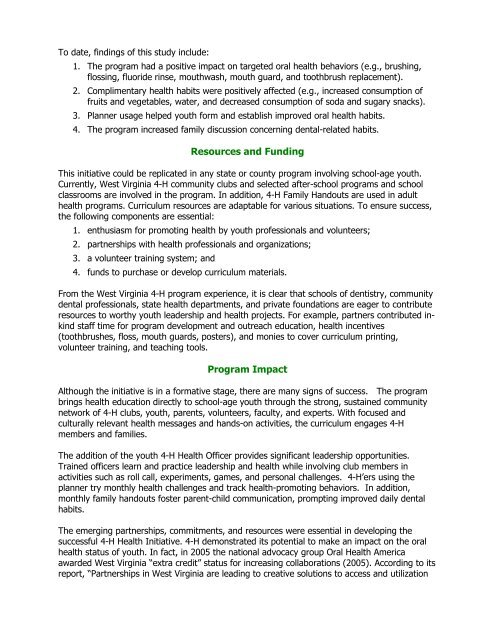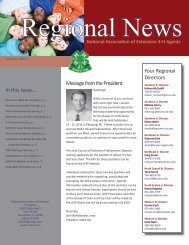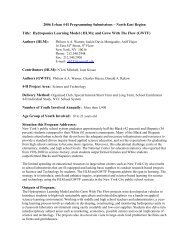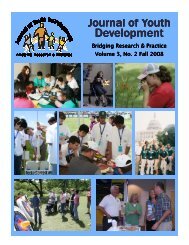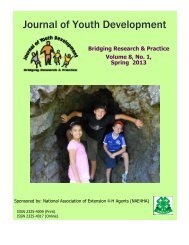Winter 2008 - Vol. 3 No. 3 - National Association of Extension 4-H ...
Winter 2008 - Vol. 3 No. 3 - National Association of Extension 4-H ...
Winter 2008 - Vol. 3 No. 3 - National Association of Extension 4-H ...
- No tags were found...
You also want an ePaper? Increase the reach of your titles
YUMPU automatically turns print PDFs into web optimized ePapers that Google loves.
To date, findings <strong>of</strong> this study include:1. The program had a positive impact on targeted oral health behaviors (e.g., brushing,flossing, fluoride rinse, mouthwash, mouth guard, and toothbrush replacement).2. Complimentary health habits were positively affected (e.g., increased consumption <strong>of</strong>fruits and vegetables, water, and decreased consumption <strong>of</strong> soda and sugary snacks).3. Planner usage helped youth form and establish improved oral health habits.4. The program increased family discussion concerning dental-related habits.Resources and FundingThis initiative could be replicated in any state or county program involving school-age youth.Currently, West Virginia 4-H community clubs and selected after-school programs and schoolclassrooms are involved in the program. In addition, 4-H Family Handouts are used in adulthealth programs. Curriculum resources are adaptable for various situations. To ensure success,the following components are essential:1. enthusiasm for promoting health by youth pr<strong>of</strong>essionals and volunteers;2. partnerships with health pr<strong>of</strong>essionals and organizations;3. a volunteer training system; and4. funds to purchase or develop curriculum materials.From the West Virginia 4-H program experience, it is clear that schools <strong>of</strong> dentistry, communitydental pr<strong>of</strong>essionals, state health departments, and private foundations are eager to contributeresources to worthy youth leadership and health projects. For example, partners contributed inkindstaff time for program development and outreach education, health incentives(toothbrushes, floss, mouth guards, posters), and monies to cover curriculum printing,volunteer training, and teaching tools.Program ImpactAlthough the initiative is in a formative stage, there are many signs <strong>of</strong> success. The programbrings health education directly to school-age youth through the strong, sustained communitynetwork <strong>of</strong> 4-H clubs, youth, parents, volunteers, faculty, and experts. With focused andculturally relevant health messages and hands-on activities, the curriculum engages 4-Hmembers and families.The addition <strong>of</strong> the youth 4-H Health Officer provides significant leadership opportunities.Trained <strong>of</strong>ficers learn and practice leadership and health while involving club members inactivities such as roll call, experiments, games, and personal challenges. 4-H’ers using theplanner try monthly health challenges and track health-promoting behaviors. In addition,monthly family handouts foster parent-child communication, prompting improved daily dentalhabits.The emerging partnerships, commitments, and resources were essential in developing thesuccessful 4-H Health Initiative. 4-H demonstrated its potential to make an impact on the oralhealth status <strong>of</strong> youth. In fact, in 2005 the national advocacy group Oral Health Americaawarded West Virginia “extra credit” status for increasing collaborations (2005). According to itsreport, “Partnerships in West Virginia are leading to creative solutions to access and utilization


